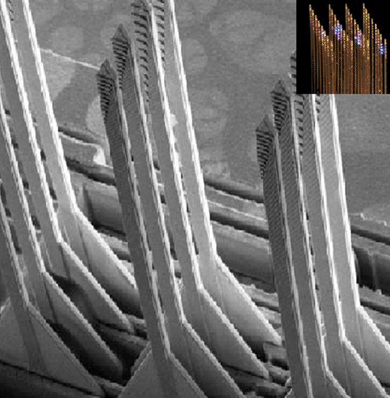Nanoelectrodes: Bridging the Gap Between Nanotechnology and Electrochemistry
Introduction to Nanoelectrodes
Nanoelectrodes are a critical component in the field of nanoelectrochemistry, which explores electrochemical processes at the nanoscale. These tiny electrodes, with at least one dimension in the nanometer range, offer unique properties and advantages compared to conventional macroscale electrodes. Nanoelectrodes find applications in areas such as electrochemical sensing, energy storage, and biomedical research.

Key Characteristics of Nanoelectrodes
Nanoelectrodes possess several distinctive characteristics that set them apart from macroscale electrodes:
- High Mass Transport: The small size of nanoelectrodes results in enhanced mass transport of analytes to the electrode surface. This is due to the hemispherical diffusion field that forms around the nanoelectrode, allowing for faster and more efficient electrochemical reactions.
- Fast Electron Transfer Kinetics: Nanoelectrodes exhibit fast electron transfer kinetics due to their high surface-to-volume ratio. The small electrode size minimizes the distance electrons need to travel, leading to rapid charge transfer and improved electrochemical performance.
- Low Capacitive Currents: The small surface area of nanoelectrodes results in low capacitive currents, which are non-faradaic currents associated with the charging and discharging of the electrical double layer. This reduction in capacitive currents leads to an improved signal-to-noise ratio and higher sensitivity in electrochemical measurements.
- Steady-State Current Response: Nanoelectrodes often display a steady-state current response, where the current reaches a constant value over time. This is in contrast to macroscale electrodes, which exhibit a time-dependent current response. The steady-state behavior of nanoelectrodes simplifies data analysis and enables the study of fast electrochemical processes.
Fabrication of Nanoelectrodes
Several methods are employed for the fabrication of nanoelectrodes, depending on the desired geometry, material, and application. Some common fabrication techniques include:
Electron Beam Lithography
Electron beam lithography (EBL) is a high-resolution technique used to pattern nanoelectrodes on a substrate. It involves using a focused electron beam to write the desired electrode pattern on an electron-sensitive resist. After development, the pattern is transferred to the underlying substrate through etching or deposition processes. EBL allows for precise control over the size, shape, and spacing of nanoelectrodes.
Focused Ion Beam Milling
Focused ion beam milling is another technique for fabricating nanoelectrodes. It utilizes a focused beam of ions, typically gallium ions, to selectively remove material from a substrate. By controlling the ion beam, nanoelectrodes with specific geometries can be directly milled into the substrate. FIB milling is particularly useful for creating nanoelectrodes on unconventional substrates or for modifying existing electrode structures.
Template-Based Synthesis
Template-based synthesis involves using a nanostructured template, such as anodic aluminum oxide (AAO) or polycarbonate membranes, to guide the growth of nanoelectrodes. The template contains nanoscale pores or channels into which the electrode material is deposited through electrochemical or chemical methods. After deposition, the template is removed, leaving behind an array of nanoelectrodes. Template-based synthesis allows for the fabrication of high-density nanoelectrode arrays with controlled dimensions.
Applications of Nanoelectrodes
Nanoelectrodes find applications in various fields due to their unique properties and advantages. Some key applications include:
Electrochemical Sensing
Nanoelectrodes are widely used in electrochemical sensing applications, such as the detection of biomolecules, environmental pollutants, and chemical species. The high mass transport and fast electron transfer kinetics of nanoelectrodes enable highly sensitive and selective detection. Nanoelectrode arrays can be functionalized with specific recognition elements, such as enzymes or antibodies, to create biosensors with improved performance.
Energy Storage and Conversion
Nanoelectrodes play a crucial role in energy storage and conversion devices, such as batteries and fuel cells. The high surface area and fast charge transfer kinetics of nanoelectrodes enhance the power density and cycle life of these devices. Nanostructured electrode materials, such as nanoparticles or nanowires, can be integrated with nanoelectrodes to further improve energy storage capacity and efficiency.
Biomedical Research
Nanoelectrodes are employed in biomedical research for various applications, such as neural stimulation and recording, electrochemical imaging, and drug delivery. The small size of nanoelectrodes allows for minimally invasive interaction with biological systems at the cellular and subcellular level. Nanoelectrodes can be used to study the electrical activity of neurons, monitor neurotransmitter release, or deliver electrical stimuli for therapeutic purposes.
Challenges and Future Perspectives
Despite the significant advancements in nanoelectrode technology, several challenges remain to be addressed. One major challenge is the reproducible and scalable fabrication of nanoelectrodes with well-defined geometries and consistent properties. Improving the long-term stability and biocompatibility of nanoelectrodes is also crucial for their reliable use in biological environments.
Future research in nanoelectrodes will focus on developing new materials and fabrication techniques to enhance their performance and expand their applications. The integration of nanoelectrodes with other nanomaterials, such as graphene or conducting polymers, can lead to the development of multifunctional and smart nanoelectrode systems. Additionally, the combination of nanoelectrodes with microfluidics and lab-on-a-chip devices will enable high-throughput analysis and miniaturized sensing platforms.
Further Reading
Journal of the Electrochemical Society, Review—Micro/Nanoelectrodes and Their Use in Electrocrystallization: Historical Perspective and Current Trends
Journal of Electroanalytical Chemistry, Nanoelectrodes for intracellular and intercellular electrochemical detection: Working principles, fabrication techniques and applications
Chemical Science, Advanced electroanalytical chemistry at nanoelectrodes
